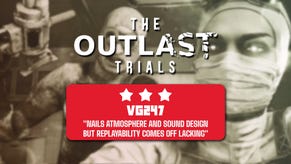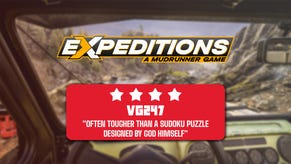Armored Hunter Gunhound EX PC Review: Robots Like They Used to Make
Hungry to stomp about in a big robot and blow stuff up? This enhanced PSP port has got you covered if Titanfall didn't quite fit the bill.
This article first appeared on USgamer, a partner publication of VG247. Some content, such as this article, has been migrated to VG247 for posterity after USgamer's closure - but it has not been edited or further vetted by the VG247 team.
Hey, remember Titanfall? That game that no-one seems to be talking about any more? Well, you may recall that during the hype train run-up to its much-aniticpated release, I was one of the few people who didn't really like it all that much.
My main beef with it wasn't necessarily that it was Call of Duty with giant robots -- although I still kind of feel that way, despite my USG compatriots' protestations to the contrary. Rather, my issue was that that its unique selling point -- the giant robots -- was underwhelming and disappointing. Although they made a pleasantly bassy "thump" noise when you walked around with them, the PC version's mouselook made them feel far too agile, and combat in them didn't feel at all weighty or interesting, particularly when two Titans started wafting impotently around in front of each other in what was supposed to be skyscraper-shaking, earth-shattering melee combat.
I bring this up because Armored Hunter Gunhound EX (hereafter simply "Gunhound"), the game that I'm actually supposed to be talking about in this article, does a far better job of making you feel like you're in control of a big hulking lump of walking metal than Titanfall ever did. And it does it through low-resolution 2D graphics rather than a super-efficient, finely-tuned 3D engine, thereby proving that it most certainly isn't all about how fancy your visuals are, it's about how satisfying your gameplay is.
And boy, is Gunhound satisfying to play.
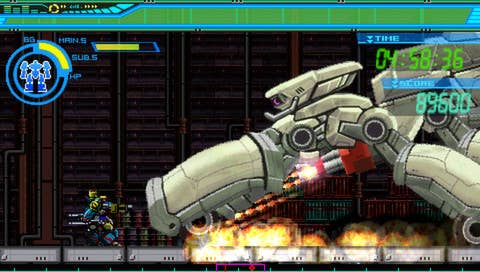
I'll admit it didn't make the best first impression. Loading up in windowed mode, sporting some horrible, horrible anti-aliasing -- low-res pixel art looks lovely as-is on high definition screens, guys; let's agree to ditch AA for 2D titles from now on, or at least turn it off by default, hmm? -- and not having any controller inputs bound by default, I found myself hitting random keys on the keyboard to figure out just how to navigate the menus. Not a great sign, but fortunately it wasn't long before I successfully managed to turn off anti-aliasing, expand the game screen to fill my television and, painstakingly, one at a time, bind the buttons and directions on an Xbox 360 controller to all the game's functions. Fortunately, you'll only have to do this once, so I'm not going to count it too much against the experience as a whole.
The first thing I did was jump into the training section. The control configuration suggested there might be a bit of a learning curve to this game, and sure enough, I was right. The training missions are challenging in and of themselves, and it's well worth going through them before jumping into the game's story-based campaign.
There are two main modes in which you'll be fighting in Gunhound: on (big, metallic, stompy) foot and in zero-G environments. Both handle markedly differently. On foot, you can stomp back and forward fairly slowly, aim your gun up and down, jump, activate your "boosters" for a higher jump or floating across gaps, and dash to both present a lower profile and move more quickly. In zero-G, meanwhile, you have to deal with your own momentum as you move around, and also the fact that as you use your Hound's thrusters to adjust your velocity and direction, you'll spin, too. Fortunately, you can lock your orientation by holding down a button, but you still have to deal with momentum -- an issue that makes navigating some of the tricky mazes in the auto-scrolling training missions in particular somewhat challenging.
What I found interesting about the on-foot sections was that, unlike some other games of this type, your robot suit doesn't handle like Super Mario. Rather, it feels weighty, clunky and cumbersome -- deliberately so. Take the booster function, for example. This could easily have been implemented as a simple double-jump, but instead it feels like you're actually using thrusters to lift a heavy lump of solid metal into the air. This means that once you start going up, it's hard to stop -- and the same for coming back down when gravity takes hold once again. Fine-tuning your control in the air is a difficult task, but one you'll need to master to take full advantage of your Hound.
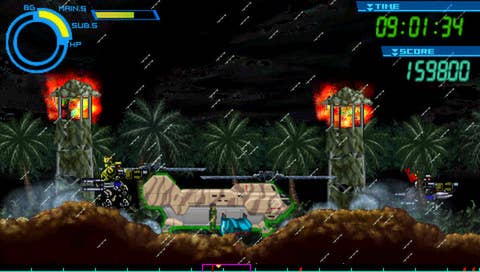
In another interesting twist, you're able to jettison your Hound's armor if your hit points start getting too low. Doing so completely refills your HP bar and, having lost a lot of weight, the Hound becomes a lot more agile, too. In other words, to fight at full effectiveness, you'll have to master not one but two very distinct handling models -- four if you count fighting in zero-G with and without armor as separate models.
It takes a while to adjust to, and it's not at all easy. Without a doubt, the learning curve for the controls will put some people off almost immediately, but for those willing to put in the time to practice and get your head around the various button combinations available, it's a rewarding experience -- and it won't be long before you're nimbly hopping about, shooting heat-seeking missiles up the arse of helicopters before deftly switching to your gatling gun to rain death down on your ground-based foes.
That satisfaction is further added to when you come to the realization that the game's story-based campaign, although short, is structured somewhat like the old-school space and flight sims of yore: you get a mission briefing, you have a series of objectives to complete, then you move on to the next one until you win. Those objectives are interesting and varied; sometimes you're escorting a larger piece of armor through the jungle; at other times you're defending a boat carrying precious cargo from attack; at others still you're sliding down the side of a mountain while attempting to fend off the unwanted attentions of what appears to be a gigantic fighter jet with legs.
The enjoyable set-pieces that make up the various stages of the campaign's missions are punctuated with enjoyable plot interludes that don't outstay their welcome. The game is packed with personality, with the player character taking on the role of Yuri, the spunky female pilot of Hound 2, supported by her two comrades and their handler Sophia. The Japanese-language voice acting is good and the text translation is mostly competent, though there are a couple of sloppy mistakes such as Sophia's name being spelled in two different ways ("Sofia" and "Sophia") at different points in the script. It's a shame the companion smartphone app isn't available outside Japan, as this allows for some minor second-screen functionality, using your portable device as a "communicator" so you can focus your attention on the screen without dialogue blocking your view.
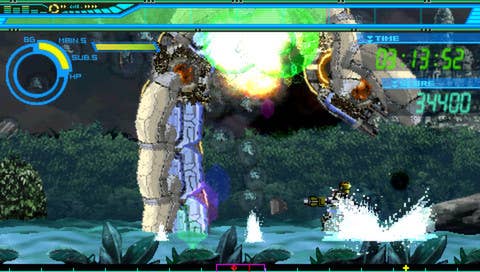
Although the campaign is short, there's plenty of replay value thanks to the game's scoring system and ability to replay any previously completed mission you like. Even the training section is replayable, since it allows you to earn score and collect medals. Progress through the game also allows you to unlock various customization options for your Hound, eventually allowing you to customize all its weaponry and its paint job. Your dream of charging into battle in a hot pink mech can now be a reality.
Ultimately, how much you get out of Gunhound will be determined by whether you can get to grips with its complicated, demanding control scheme and steep learning curve. It's a game that some people will try, be put off after five minutes and never return to, while others will become increasingly obsessive about attaining as high a score as possible while mastering everything their Hound has to offer. It's a pleasingly old-school experience that will prove particularly rewarding for gamers of a certain age (such as myself), and if you feel you might fall into that category, there are far worse things you could drop $15 on.
- Visuals: Even with anti-aliasing turned off, the game's PSP origins are apparent in its blurry visuals. There's a lot of detail, though -- soldiers running around on foot beneath your Hound, maneuvering jets firing as you adjust your direction in zero-G sections -- and the game runs at a rock-solid 60 frames per second, for those who care about such things.
- Music and Sound: There's a rockin' soundtrack that fits the action, though you probably won't be humming it to yourself afterwards. Japanese voice acting is strong and fits the characters well.
- Interface: The menus are clunky and the fact you have to manually set up a controller -- including directional controls -- is a pain, but once it's done, it's done, and you can concentrate on the game. In-game, the on-screen displays are clear and easy to understand.
- Lasting Appeal: The game's campaign is only about three hours long, but lasting appeal comes from replays for high scores or one-credit clears.
ConclusionAn unashamedly old-school game, but one which, surprisingly, captures the feeling of wrestling with the controls of a lumbering, hulking chunk of walking metal better than pretty much any other title in recent memory.







